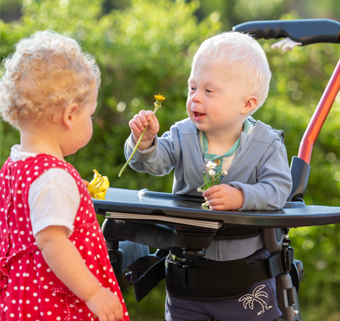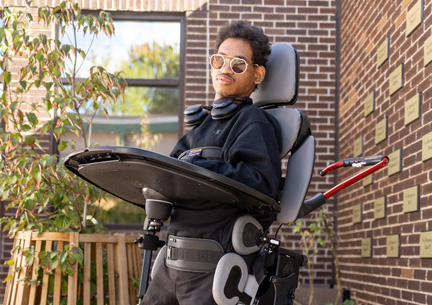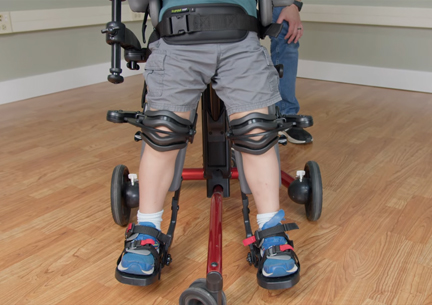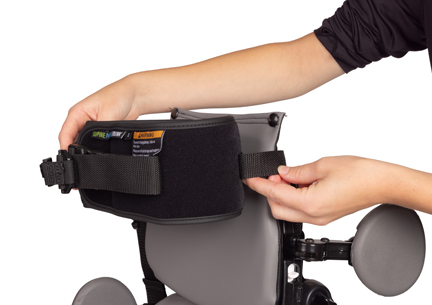Adaptive Standing for Contracture Management in Cerebral Palsy
| April 2024 Cerebral palsy (CP), one of the most common physical disabilities, is the result of a neural lesion of the brain. There is a loss of neural connection resulting in altered muscle activation, weakness, and fatigue. Simultaneously, there is a loss of inhibition which results in spasticity of the muscles. Interestingly, this muscle hypertonia and weakness can occur in the same muscle. While the actual lesion is static and unchanging, the musculoskeletal effects of CP typically worsen as the child grows.
Cerebral palsy (CP), one of the most common physical disabilities, is the result of a neural lesion of the brain. There is a loss of neural connection resulting in altered muscle activation, weakness, and fatigue. Simultaneously, there is a loss of inhibition which results in spasticity of the muscles. Interestingly, this muscle hypertonia and weakness can occur in the same muscle. While the actual lesion is static and unchanging, the musculoskeletal effects of CP typically worsen as the child grows.
Determinants of Contracture in Cerebral Palsy
Muscles in cerebral palsy are notably reduced in volume, and although the tendons may present as longer, the overall muscle is often shorter in length. Further differences at the cellular level contribute toward muscles that are not only smaller and weaker but are stiffer with more tightness and less extensibility than typical muscle (Handsfield 2022). These muscle deficits can result in a cycle of inactivity: as children with CP participate in less physical activity, they have decreased opportunity for mechanical loading, which in turn results in further muscle weakness and decreased muscle flexibility.
Structural abnormalities frequently increase with age and are evident beyond the growth years into adulthood (Ágústsson 2019). Children with cerebral palsy do not have any skeletal distortion at birth: their muscles and joints appear typical. However, during development, we observe the widely recognized combination of knee and hip flexion contractures, with progressively worsening pelvic obliquity and hip rotation. These contribute to the lower extremity pattern known as wind-swept deformity, along with hip dislocation and scoliosis (Sato, 2022). These bodily distortions are more evident in children with postural asymmetry and decreased motor function (Nordmark 2009, Casey 2022, Casey 2022).
Knee contracture occurs in children at all GMFCS levels (Cloodt 2021, Cloodt 2002), with knee flexion contracture being of primary concern. There is an association between the severity of knee flexion contracture and reduced functional mobility, including decreased ability for standing and transfer (Pantzar-Castilla 2021). Recently, a scoliosis risk score has determined limited knee extension to be one of four predictors for scoliosis (Pettersson 2020). Knee contracture is notably associated with higher GMFCS levels, increasing age, and hamstring muscle shortness. Muscle spasticity appears to have a smaller effect on contracture development (Cloodt 2018).
Although this topic is beyond the scope of this article, it is interesting to consider that perhaps the crouched gait pattern contributes to knee flexion contracture, more so than knee flexion contracture contributes to crouched gait. Factors such as muscle weakness, postural stability, and balance have an influence on crouched gait. In stance, knee extensor weakness contributes to knee flexion, whereas in the swing phase of gait, passive knee flexion range-of-motion modulates the knee pattern. As for muscle spasticity, it does have a recognized role in knee flexion during gait: knee extensor hypertonia is the greatest contributor to knee flexion in both the stance and swing phases. (Manikowska 2022.)
While we recognize that muscle shortening occurs in cerebral palsy (Cloodt 2021, Cloodt 2022) and contributes to deformity and a cycle of inactivity, the mechanisms of the structural changes that result in muscle contracture are not fully understood. Additional research is needed to determine effectiveness of interventions that to date have included passive manual stretching, serial casting, orthoses, and the use of standing devices. A Cochrane review published in 2010 with an abridged republication in 2017, concludes that stretch does not have clinically important effects on joint mobility (Katalinic 2010, Harvey 2017). Earlier publications stated that evidence is inconclusive to either support or refute stretching for preventing contractures (Wiart 2008, Craig 2016, Eldridge 2016). Therefore, passive manual stretching in isolation is not considered an effective intervention for contracture management (Novak 2020).
Adaptive Standing for Contracture Management
Published systematic reviews, however, offer a positive outlook on the potential of supported standing to either prevent or ameliorate contractures (Paleg 2013, Occhipintti 2018, McLean 2023). And the following experimental studies included in these reviews describe positive outcomes with children placed in adaptive standers.
In a 2009 study, five non-mobile children were placed in standing for one hour, five days a week, for six weeks (Gibson 2009). This was followed by six weeks of no standing. These phases were repeated. The hamstring muscles lengthened (reducing knee flexion contracture) during the standing phase, and shortened during the non-standing phase.
A 2020 study compared static standing to dynamic movement in the upright position (Tornberg, 2020). Twenty non-ambulatory children between five and seven years of age were randomly assigned to either static standing or dynamic standing intervention for a minimum of thirty minutes daily for four months. After a two-week washout period, the children were placed in the other device for thirty minutes daily for four more months. Both interventions improved range of motion in hip abduction, hip external rotation, and hip extension. Interestingly, the dynamic movement opportunity also increased the range of movement in the opposite directions - ie, flexion, adduction, and internal rotation. This may be less relevant for contracture but certainly is interesting to see.
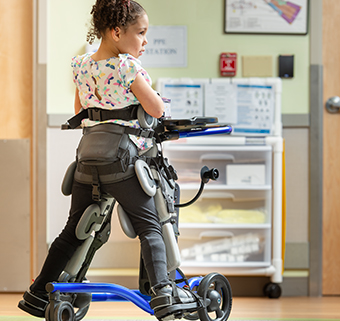
A longitudinal retrospective case-control study took measurements of children’s hip abduction and knee extension (Martinsson 2021). It is interesting to notice that the children began the supported standing at a fairly young age, ranging from a little over one year old to eleven years old, and data was collected over seven years. Children stood for ten hours per week, and the study groups stood in fifteen to thirty degrees of hip abduction. Children in the study groups did not develop any contractures. This 2021 contribution to research strongly indicates that adaptive standing in abduction can prevent contractures.
Further, a preliminary randomized control trial with ten children, published in 2022, was set up in the United Kingdom as a feasibility study in preparation for a future larger RCT (Rapson 2022). This twelve month study recruited children with CP at GMFCS levels III, IV, and V. The researchers determined the baseline average standing time of the children, and then doubled their standing time for the intervention group. The participants used their existing standing frames and orthotics. The average daily standing time of the intervention group was fifty-eight minutes daily on weekdays and forty-nine minutes daily on average overall. The researchers measured ankle, knee, and hip range of motion. The children who spent more time standing showed statistically significant improvement in knee and hip range, whereas the children who continued their usual standing showed statistically significant improvement in knee and ankle range. Both groups showed increased knee ROM with the knee extension position in standing.
Results from an individual case study published in 2020 are also promising. A sixteen year-old young man, GMFCS Level V, was placed in a stander that accommodated his hip and knee flexion contractures. The average standing frequency was three times a week for approximately one hour per session. Over fifteen months, his knee extension and hip extension were increased intentionally and gradually every week. At the same time, the overall angle of the stander was gradually moved into a more upright position.
Table 1 shows that the subject’s hip extension increased bilaterally, and his right knee extension also increased. Only the left knee flexion remained essentially the same. Since this individual is sixteen years old, his contractures may be long standing. Since this an individual case study it does not hold a lot of weight in terms of data. However, the results do effectively support the concept of the use of adaptive standing for improving range of motion.
Table 1
|
Hip Flexion |
Right |
Left |
|
Baseline |
25° |
40° |
|
15 mo Post |
0° |
20° |
|
Knee Flexion |
Right |
Left |
|
Baseline |
40° |
30° |
|
15 mo Post |
20° |
35° |
Table 1 shows the improvement in range of motion measurements.
Early Intervention and Standing
It is exciting to consider the possible results if we could begin this intervention earlier. In Paleg and Livingstone’s 2022 evidence-informed clinical perspectives on postural management, they encourage “supported standing in ten to fifteen degrees hip abduction bilaterally (twenty to thirty degrees total) at least one hour daily as an important change of position from sitting or lying” beginning at nine months of age. (Paleg 2022).
Similarly, Morgan’s 2021 international clinical practice guideline based on systematic reviews, suggests regular use of standing equipment for positioning as part of an active intervention program. This is recommended particularly for children with or at high risk of CP, at the age when weight-bearing in standing would begin in children who are non-weight bearing (Morgan 2021).
Cerebral palsy affects numerous individuals worldwide, many of whom experience range of motion limitations that negatively impact function. Recent research strengthens the available evidence supporting the use of adaptive standing for contracture management. With regular standing opportunity at any age, joint range of motion can be maintained and potentially improved. And with adaptive standing in early intervention, particularly in the abduction position, the development of contracture may be avoided completely, enabling children with cerebral palsy to experience better musculoskeletal health, function, and quality of life.
References
- Ágústsson A, Sveinsson T, Pope P, Rodby-Bousquet E. Preferred posture in lying and its association with scoliosis and windswept hips in adults with cerebral palsy. Disabil Rehabil. 2019;41(26):3198-3202. doi:10.1080/09638288.2018.1492032
- Capati V, Covert SY, Paleg G. Stander Use for an Adolescent with Cerebral Palsy at GMFCS Level with Hip and Knee Contractures. Assist Technol. 2020;32(6):335-341. doi:10.1080/10400435.2019.1579268
- Casey J, Agustsson A, Rosenblad A, Rodby-Bousquet E. Relationship between scoliosis, windswept hips and contractures with pain and asymmetries in sitting and supine in 2450 children with cerebral palsy. Disabil Rehabil. 2022;44(22):6738-6743. doi:10.1080/09638288.2021.1971308
- Casey J, Rosenblad A, Rodby-Bousquet E. Postural asymmetries, pain, and ability to change position of children with cerebral palsy in sitting and supine: a cross-sectional study. Disabil Rehabil. 2022;44(11):2363-2371. doi:10.1080/09638288.2020.1834628
- Cloodt E, Lindgren A, Lauge-Pedersen H, Rodby-Bousquet E. Sequence of flexion contracture development in the lower limb: a longitudinal analysis of 1,071 children with cerebral palsy. BMC Musculoskelet Disord. 2022;23(1):629.. doi:10.1186/s12891-022-05548-7
- Cloodt E, Rosenblad A, Rodby-Bousquet E. Demographic and modifiable factors associated with knee contracture in children with cerebral palsy. Dev Med Child Neurol. 2018;60(4):391-396. doi:10.1111/dmcn.13659
- Cloodt E, Wagner P, Lauge-Pedersen H, Rodby-Bousquet E. Knee and foot contracture occur earliest in children with cerebral palsy: a longitudinal analysis of 2,693 children. Acta Orthop. 2021;92(2):222-227. doi:10.1080/17453674.2020.1848154
- Craig J, Hilderman C, Wilson G, Misovic R. Effectiveness of Stretch Interventions for Children With Neuromuscular Disabilities: Evidence-Based Recommendations. Pediatr Phys Ther. 2016;28(3):262-275. doi:10.1097/PEP.0000000000000269
- Eldridge F, Lavin N. How effective is stretching in maintaining range of movement for children with cerebral palsy? A critical review. Int J Ther Rehabil. 2016;23(8):386–395. http://dx.doi.org/10.12968/ijtr.2016.23.8.386
- Gibson SK, Sprod JA, Maher CA. The use of standing frames for contracture management for nonmobile children with cerebral palsy. Int J Rehabil Res. 2009;32(4):316-323. doi:10.1097/MRR.0b013e32831e4501
- Handsfield GG, Williams S, Khuu S, Lichtwark G, Stott NS. Muscle architecture, growth, and biological Remodelling in cerebral palsy: a narrative review. BMC Musculoskelet Disord. 2022;23(1):233. doi:10.1186/s12891-022-05110-5
- Harvey LA, Katalinic OM, Herbert RD, Moseley AM, Lannin NA, Schurr K. Stretch for the treatment and prevention of contracture: an abridged republication of a Cochrane Systematic Review. J Physiother. 2017;63(2):67-75. doi:10.1016/j.jphys.2017.02.014
- Katalinic OM, Harvey LA, Herbert RD, Moseley AM, Lannin NA, Schurr K. Stretch for the treatment and prevention of contractures. Cochrane Database Syst Rev. 2010;(9):CD007455. doi:10.1002/14651858.CD007455.pub2
- Manikowska F, Brazevič S, Jóźwiak M, Lebiedowska MK. Contribution of Different Impairments to Restricted Knee Flexion during Gait in Individuals with Cerebral Palsy. J Pers Med. 2022;12(10):1568. doi:10.3390/jpm12101568
- Martinsson C, Himmelmann K. Abducted Standing in Children With Cerebral Palsy: Effects on Hip Development After 7 Years. Pediatr Phys Ther. 2021;33(2):101-107. doi:10.1097/PEP.0000000000000789
- McLean LJ, Paleg GS, Livingstone RW. Supported-standing interventions for children and young adults with non-ambulant cerebral palsy: A scoping review. Dev Med Child Neurol. 2023;65(6):754-772. doi: 10.1111/dmcn.15435.
- Morgan C, Fetters L, Adde L, et al. Early Intervention for Children Aged 0 to 2 Years With or at High Risk of Cerebral Palsy: International Clinical Practice Guideline Based on Systematic Reviews. JAMA Pediatr. 2021;175(8):846-858. doi:10.1001/jamapediatrics.2021.0878
- Nordmark E, Hägglund G, Lauge-Pedersen H, Wagner P, Westbom L. Development of lower limb range of motion from early childhood to adolescence in cerebral palsy: a population-based study [published correction appears in BMC Med. 2010;8:49]. BMC Med. 2009;7:65. Published 2009 Oct 28. doi:10.1186/1741-7015-7-65
- Novak I, Morgan C, Fahey M, et al. State of the Evidence Traffic Lights 2019: Systematic Review of Interventions for Preventing and Treating Children with Cerebral Palsy. Curr Neurol Neurosci Rep. 2020 Feb 21;20(2):3. doi: 10.1007/s11910-020-1022-z.
- Occhipintti A, Mendoza SM. Efficacy of passive standing programmes in children with cerebral palsy: a systematic review. Fisioterapia. 2018;40(3):153–164. https://doi.org/10.1016/j.ft.2018.02.004
- Paleg G, Livingstone R. Evidence-informed clinical perspectives on postural management for hip health in children and adults with non-ambulant cerebral palsy. J Pediatr Rehabil Med. 2022;15(1):39-48. doi: 10.3233/PRM-220002. PMID: 35275575.
- Paleg GS, Smith BA, Glickman LB. Systematic review and evidence-based clinical recommendations for dosing of pediatric supported standing programs. Pediatr Phys Ther. 2013;25(3):232-247. doi:10.1097/PEP.0b013e318299d5e7
- Pantzar-Castilla EHS, Wretenberg P, Riad J. Knee flexion contracture impacts functional mobility in children with cerebral palsy with various degree of involvement: a cross-sectional register study of 2,838 individuals [published correction appears in Acta Orthop. 2021 Aug;92(4):500]. Acta Orthop. 2021;92(4):472-478. doi:10.1080/17453674.2021.1912941
- Pettersson K, Wagner P, Rodby-Bousquet E. Development of a risk score for scoliosis in children with cerebral palsy. Acta Orthop. 2020;91(2):203-208. doi:10.1080/17453674.2020.1711621
- Rapson R, King T, Morris C, et al. Effect of different durations of using a standing frame on the rate of hip migration in children with moderate to severe cerebral palsy: a feasibility study for a randomised controlled trial. Physiotherapy. 2022;116:42-49. doi:10.1016/j.physio.2022.01.001
- Sato H. Postural deformity in children with cerebral palsy: Why it occurs and how is it managed. Phys Ther Res. 2020;23(1):8-14. Published 2020 Jun 20. doi:10.1298/ptr.R0008
- Tornberg ÅB, Lauruschkus K. Non-ambulatory children with cerebral palsy: effects of four months of static and dynamic standing exercise on passive range of motion and spasticity in the hip. PeerJ. 2020;8:e8561. doi:10.7717/peerj.8561
- Wiart L, Darrah J, Kembhavi G. Stretching with children with cerebral palsy: what do we know and where are we going?. Pediatr Phys Ther. 2008;20(2):173-178. doi:10.1097/PEP.0b013e3181728a8c


